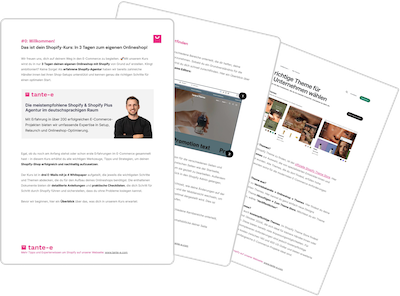Every brand that wants to grow internationally with Shopify will sooner or later face the question of a suitable translation app. Often, simply having multilingual texts isn't enough: What matters is how the translations are technically implemented in the store and what features the solution offers for product data, metadata, navigation structures, or third-party apps.
In our daily work as a Shopify agency, we repeatedly notice with our clients that not every solution is suitable for every shop. Different requirements require different tools. In this article, we compare three proven tools: Shopify Translate & Adapt, Weglot, and Langshop.
When do we recommend which app, how do the solutions differ, and in which specific shops are they used? Learn how to make the right decision for your shop. This article is based on the insights of our expert Lara.

At tante-e, Lara works directly with numerous e-commerce brands and helps them optimize their stores.
1. Shopify Translate & Adapt vs. Weglot vs. Langshop: 3 translation apps in direct comparison (as of June 2025)
In our projects, we regularly rely on three established translation apps, each with a different focus: Shopify Translate & Adapt , Weglot , and Langshop . Each of these solutions has its own strengths and limitations – both in terms of technical integration and in terms of feature set, level of automation, and cost model.
| criterion | Shopify Translate & Adapt | Weglot | Langshop |
|---|---|---|---|
| Cost structure | For free | offers a free plan to try out, starter from 15 euros (packages depend on the number of words) | offers Free Plan, Basic from 10 euros (packages depend on number of products) |
| Number of languages | Up to 2 languages automated, others manually or via workaround | Free/Starter: 1, Business: 3, Pro: 5, Advanced: 10, Extended: 20 | Free: 1, Basic: 1, Standard: 3, Advanced: 5, Pro: 10, Enterprise: 20, Unlimited: 20 |
| Adjustments to alt texts | only via workaround | Yes | Yes |
| Product images | No | Yes (alternative media files) | Yes (supports localization of images & alt tags) |
| Translation of app content | Limited availability | Many third-party apps supported (e.g. Klaviyo, Yotpo, Pagefly) | Yes, if third-party app content is present in the source code |
| compatibility | No collection filters & tags, but checkout possible | Checkout only possible with difficulty, collection filters & tags supported | Checkout (via theme languages), collection filters, tags supported |
| Visual editing | Not available | Visual Editor with Live View | Not available |
| Access to Translation API | Yes | No access | Yes |
This overview forms the basis for our recommendations. It helps you select the right app early on to avoid later limitations in scaling or technical implementation. Our experience clearly shows: The more clearly the requirements are defined at the outset, the more effectively the right solution can be integrated.
2. When we use which translation app
Which translation app we recommend always depends on the specific setup and requirements of the respective brand. Factors such as the number of languages, SEO relevance, the technical structure of the store, and future scalability all play a crucial role. Below, we'll show you which solution has proven successful in which situations.
2.1. Shopify Translate & Adapt: For lean setups with few languages
This app is particularly suitable for shops that want to start with a lean language offering while maintaining maximum control over their content. Since up to two languages can be automatically translated, the solution is ideal for shops that want to enter international markets for the first time, for example, with English and Dutch in addition to their main German market.
Translations can be manually revised directly in the Shopify admin. This allows for careful linguistic fine-tuning without the need for additional tools. Shopify Translate & Adapt also offers advantages in terms of budget, as it's completely free. Technically, everything remains within the Shopify ecosystem, saving effort on integration and maintenance.
2.2. Weglot: Shops with a wide range of languages
Weglot is used in projects that require support for multiple languages and that require as much automation as possible. With over 100 available languages, an integrated visual editor, and features like global substitution rules, Weglot offers Shopify merchants a high degree of flexibility.
Weglot is often the right choice, especially for shops with a strong international focus and SEO relevance. The app translates not only visible content in the shop, but also dynamic elements, alt text, and parts of third-party apps (provided the respective integration is supported).
Weglot is also suitable for retailers who want to import existing translations and make adjustments directly and intuitively using the Visual Editor.
2.3. Langshop: Complex shops with flexible requirements
Langshop is our recommendation for shops with a complex structure, numerous products, and customized requirements. The app allows a combination of automatic, manual, and professional translation, for example, through integration with DeepL Pro or external translators.
Technically, Langshop goes beyond the standard. Among other things, filters, tags, product images including alt text, and content from the checkout area can be translated. Access to APIs and control via customized workflows are also possible. The glossary allows specific words, such as brand names, to be excluded from translation.
3. 3 practical examples
Selected customer projects clearly demonstrate how we at tante-e use translation apps in specific Shopify setups. The following examples illustrate typical scenarios that frequently occur in our daily work – and which solution has proven to be the most suitable in each case.
3.1. 3Bears – Lean setup with Translate & Adapt for the British and Dutch markets

For the 3Bears brand, the focus was on expanding the shop to include two new target markets: the United Kingdom and the Netherlands. The existing German-language shop was to be expanded to include two additional languages without any additional technical effort.
We recommended Translate & Adapt as a solid foundation. The automated translation of both languages was performed directly via the Shopify backend. The setup proved to be efficient and low-maintenance, ideal for the planned scaling with a manageable language scope.
3.2. reisenthel – Workaround with Shopify Translate & Adapt

In reisenthel's case, this involved strategically preparing for five additional language versions: English, France, Spanish, Italian, and Dutch. We used a workaround with Shopify Translate & Adapt. Although the project was still in its early stages at the time of planning, Translate & Adapt was integrated into the system landscape early on to enable smooth scaling.
3.3. Kess Berlin – Weglot in action

Kess Berlin pursued a comprehensive internationalization approach with multiple language versions, a geolocation popup, and a switcher solution in the navigation, allowing customers to select the appropriate markets and languages.
Weglot was chosen as the translation app because of its technical flexibility and visual customization. This ensured stable performance and streamlined backend maintenance.
4. Conclusion: Our recommendations at a glance
The right translation app for Shopify always depends on the specific setup. Key factors include language scope, technical requirements, internal resources, and strategic goals.
Shopify Translate & Adapt is suitable for stores with a limited number of languages and a clear budget. The app is free, integrated, and well-suited for editorially curated content.
Weglot is ideal for brands with multiple languages, high automation needs, SEO focus, and a desire for translations independent of the Translate API.
Langshop is suitable when a shop has a complex structure, contains many products and requires individual translation processes.
Our projects show that the best solution is the one that fits a brand's goals, processes and technical infrastructure.


